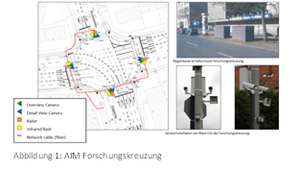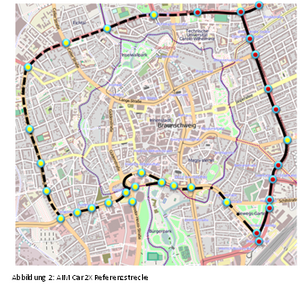Living Lab Automotive
Contact
Project Lead
Prof. Dr. Frank Köster
Frank.Koester(at)dlr.de
Living Lab Automotive
Application platform Intelligent Mobility (AIM)
Mobility cannot be reduced to a single phenomenon such as the number of travelled miles or the amount of driven roads. Essential and characteristic for a positive experience of the quality of mobility is the unlimited possibility to choose among a selection of goals, time point routes and means of transportation according to individual preferences and needs. Incomprehensible restrictions are generally experienced as an immediate loss of quality.
The ever increasing demand of mobility (transport of persons and goods) leads to an according growth in traffic volume that often results in congestions, traffic disturbances or other negative impacts.
Mobility is thus a highly topical field of action with direct implications for our current economy and social life. A critical consideration of mobility volume and an efficient usage of different mobility options including their smart interplay as well as a development of single concrete solutions, e.g., as cooperative and highly autonomous vehicles in the urban space are thus of central importance – Avoid, Relocate, Improve.
The idea of the Living Lab AIM
The German Aerospace Center (Deutsches Zentrum für Luft- und Raumfahrt, DLR) actively supports research in this domain for several years. In AIM, the DLR works in close cooperation with the state of Lower Saxony, the city of Braunschweig and other stakeholders from science, economy and public authorities. AIM is a living lab that enables and facilitates research and development in the area of intelligent mobility services. The living lab AIM contains crucial parts of the real environment in the city of Braunschweig as well as surrounding regions, specific test tracks and a powerful equipment for the simulation of and influence on macroscopic (e.g., traffic flow) and microscopic (e.g. driver and driving behavior) aspects of traffic and mobility.
Approximately one million inhabitants of the metropolitan area Hannover / Braunschweig / Göttingen / Wolfsburg contribute with their mobility behavior to AIM. Their individual mobility needs and their daily usage as well as the combination of available transportation means provide a manifold traffic situation that embed research and development activities in AIM.
The Institute of Transportation Systems at the DLR in Braunschweig has the lead management for AIM. The parts of this living lab can be practically used since the end of 2013.
AIM contains multiple components
AIM can be compared with a toolkit characterized by the flexibility of its components – in AIM these components are referred to as services. For instance, various simulation models and simulators can be integrated and used in combination with psychological experiments and field studies to provide a wide range of empirical research opportunities. Thus, critical situations in the traffic flow, e.g. at intersections (see Figure 1) or at level crossings can be integrated very early in the development of future assistance systems.

Figure 1. AIM research intersection.
An additional key aspect of AIM is the Car2X reference track of 11.2 km length on which, among others, cooperative vehicle and infrastructure systems can be evaluated and technically refined (see Figure 2).
In addition, AIM provides a fleet of specifically-equipped test vehicles that enable a campaign-specific examination of advanced assistance and automation systems as well as individual driving behaviors. An efficient integrated hardware and software architecture supported by state-of-the-art data management services and backend systems facilitates the interconnectedness of mobility participants and technical systems in a cooperative sense.

Figure 2. AIM Car2X reference track in the city of Braunschweig.
AIM always enables a smooth connection of empirical tests and simulations as well as the transformation of scientific insights into reality.
The living lab AIM thus makes an invaluable contribution to the design of a general framework and the determination of requirements for tomorrow’s mobility. AIM demonstrates the feasibility of innovative mobility services and their responsible transformation into a living consumer market.
Long-term thinking and reutilization
In the design of AIM, it has been taken care that the living lab AIM will exist for a long time. This is guaranteed by the fact the AIM services will be used in several research and development activities. Central functions and components already exist and are evaluated in various projects and hence add value to the living lab AIM. Outstanding examples for this are the abovementioned services research intersection and Car2X reference track
Manifold spectrum of services
The central concept for the structure of the living lab AIM contains 23 services that enable various research and development activities in the following key topics:
- Traffic flow
- Inter- and multimodal mobility concepts
- Market roll out and migration
- Mobility awareness
In sum, these activities are directed to serve higher-order goals as increased safety for all traffic participants and careful use of resources (in terms of life-time enhancement and environmental orientation). AIM supports projects from the economy and the scientific community through its extensive infrastructure that allows activities with highly systemic demands as well as those with technical depth.
Usage in the research project Critical Systems Engineering for Socio-Technical System (CSE)
The living lab AIM is one of CSE’s most important project columns, especially in the subprojects “Car that Cares” and “The Safety Impact of Security”.


